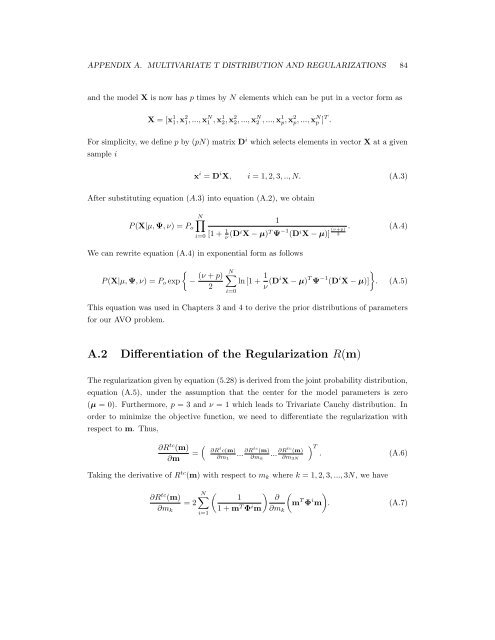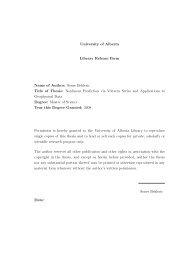Regularization of the AVO inverse problem by means of a ...
Regularization of the AVO inverse problem by means of a ...
Regularization of the AVO inverse problem by means of a ...
You also want an ePaper? Increase the reach of your titles
YUMPU automatically turns print PDFs into web optimized ePapers that Google loves.
APPENDIX A. MULTIVARIATE T DISTRIBUTION AND REGULARIZATIONS 84<br />
and <strong>the</strong> model X is now has p times <strong>by</strong> N elements which can be put in a vector form as<br />
X = [x 1 1, x 2 1, ..., x N 1 , x 1 2, x 2 2, ..., x N 2 , ..., x 1 p, x 2 p, ..., x N p ] T .<br />
For simplicity, we define p <strong>by</strong> (pN) matrix D i which selects elements in vector X at a given<br />
sample i<br />
x i = D i X, i = 1, 2, 3, .., N. (A.3)<br />
After substituting equation (A.3) into equation (A.2), we obtain<br />
P (X|µ, Ψ, ν) = Po<br />
N<br />
i=0<br />
1<br />
[1 + 1<br />
ν (DiX − µ) T Ψ −1 (DiX − µ)] (ν+p)<br />
2<br />
We can rewrite equation (A.4) in exponential form as follows<br />
<br />
(ν + p)<br />
P (X|µ, Ψ, ν) = Po exp −<br />
2<br />
N<br />
i=0<br />
. (A.4)<br />
ln [1 + 1<br />
ν (DiX − µ) T Ψ −1 (D i <br />
X − µ)] . (A.5)<br />
This equation was used in Chapters 3 and 4 to derive <strong>the</strong> prior distributions <strong>of</strong> parameters<br />
for our <strong>AVO</strong> <strong>problem</strong>.<br />
A.2 Differentiation <strong>of</strong> <strong>the</strong> <strong>Regularization</strong> R(m)<br />
The regularization given <strong>by</strong> equation (5.28) is derived from <strong>the</strong> joint probability distribution,<br />
equation (A.5), under <strong>the</strong> assumption that <strong>the</strong> center for <strong>the</strong> model parameters is zero<br />
(µ = 0). Fur<strong>the</strong>rmore, p = 3 and ν = 1 which leads to Trivariate Cauchy distribution. In<br />
order to minimize <strong>the</strong> objective function, we need to differentiate <strong>the</strong> regularization with<br />
respect to m. Thus,<br />
∂R tc (m)<br />
∂m<br />
=<br />
∂R t c(m)<br />
∂m1<br />
... ∂Rtc (m)<br />
... ∂mk<br />
∂Rtc (m)<br />
∂m3N<br />
T<br />
. (A.6)<br />
Taking <strong>the</strong> derivative <strong>of</strong> R tc (m) with respect to mk where k = 1, 2, 3, ..., 3N, we have<br />
∂Rtc N<br />
<br />
(m)<br />
= 2<br />
∂mk<br />
i=1<br />
1<br />
1 + m T Φ i m<br />
∂<br />
∂mk<br />
<br />
m T Φ i <br />
m . (A.7)









